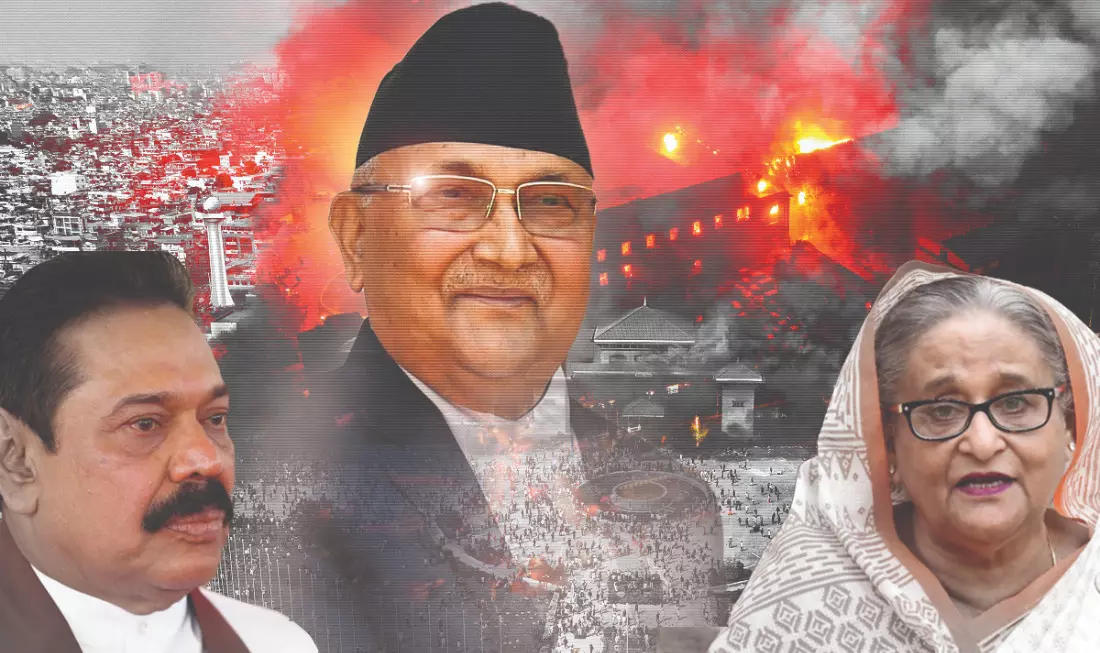Corruption & Collapse
From Bangladesh to Nepal, corruption has sparked unrest, regime change, and foreign meddling. India must learn, act, and secure itself before the same forces exploit its vulnerabilities

Corruption is the only common factor that is evident in all the recent unrest in this part of the globe, with the change of regimes associated with severe violence, besides widespread civil conflict, loss of lives and properties, as one is witnessing in Nepal. Previously, similar actions were seen in Bangladesh, Sri Lanka, and, prior to that, in Myanmar too.
Be it K. P. Sharma Oli in Nepal, Sheikh Hasina in Bangladesh, or Rajapaksa in Sri Lanka, all were heading governments that were seen to be corrupt by the citizens, mainly comprising the youth, and shown the door. Corruption at the leadership level breeds similar traits down the entire government machinery. Beyond a threshold, it becomes untenable and is only held onto by political powers for continued survival. Hegemonic forces, which turn inimical to any government, lurk in the back in search of the right opportunity to change the regime that doesn’t toe its line.
It was St. Martin Island that Sheikh Hasina refused to hand over to the Americans since 2017. What followed next in Bangladesh was a smart, rather cunning, move by the U.S. agencies—the application of cognitive warfare, or war without weapons. In Bangladesh, it was effortlessly carried out by some innocuous organisations of the West and ultimately, after six years, it was the ouster of Sheikh Hasina from Bangladesh. Only time will tell if the current puppet regime of the country will be able to fulfil the demands of the mighty West (sic: America), but at least he is friendly and trying his best to appease his western bosses by following their dictum. However, the cost that the citizens of Bangladesh would have to pay will be very dear to come back to par, if at all, and at a very high premium! Alas, Nepal too is now following the same suit.
The failed general of Pakistan, who elevated himself as the field marshal even after a thorough defeat at Op Sindoor, is fully tuned up to his master’s voice of America and, through the notorious agency ISI, would be hand in glove with the actors in the neighbourhood, helping and orchestrating such actions. These behind-the-scenes forces very aptly engage the citizens, mainly the youth, to pull such manoeuvres successfully.
It is certain that India is also on their radar and target list, but, due to its unity in diversity, besides its vastness, they are unable to get any foothold in spite of relentless endeavours. “Project 37” was one such attempt launched by the nefarious forces that failed even before its take-off, as the game plan was leaked beforehand. Well, that’s a different subject and, between us, can be taken up at an opportune time later.
Now the moot point before India is to make a quick evaluation of the pros and cons and take due mid-course corrections.
In hindsight, corruption is a serious challenge in India too, which is harming society and governance silently, like termites. There is shimmering anger and anguish among the people of the nation, and several state governments are prone, rather vulnerable, to large-scale corruption that has taken alarming proportions in the respective states, which can burst like a balloon at any given point of time, and possibly may give a potential handle to the enemies that can be misused by them to harm India, as they have done in the neighbourhood.
To effectively thaw the same, the police and also the other security apparatus need to be kept on high alert and carry out periodical mock drills to prevent any loss of lives and properties. Going a step further, it is advisable that the armed forces, which are often called to help the civil administration at times of need, should be kept in the loop and swiftly act in an effective manner at the nth moment, at the actual time on the ground. To minimise the damage, a Standard Operating Procedure (SOP) should be put in place to avoid any loss of time to deploy the Army. As said earlier at this forum, especially at all the vulnerable places like the chicken neck, the Siliguri corridor along the Bihar–West Bengal border with Bangladesh, regular flag marches by the Army would be able to instil a sense of confidence among the law-abiding citizens while administering fear among the enemy forces and their sleeper cells active in parts of India awaiting to inflict harm. The time taken to call the Army to civil aid, including that of deteriorating law and order, is about four to five hours, and naturally during that period a lot of damage is already done, but that can easily be avoided by promulgating a well-planned procedure, an SOP in place, which should be worked out without any loss of time by the concerned authorities. Law and order is a state subject, but, cutting across all differences and existing procedures, this SOP is essential to be part of the country’s security doctrine due to its serious nature and larger public interest. Ultimately, all the local state governments, along with the federal government at the Centre, are for the public, and in our current state of democratic set-up, work in tandem as a welfare nation to aid the citizens of the country. Thus, it will be in the overall national interest to formulate an SOP and be prepared to tackle any adverse situations.
Views expressed are personal. The writer is a senior IAF officer with long experience of civil administration in government in various disciplines/ministries



